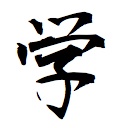Learn to Write 94.5% of Kanji in 8 Months
Learning by rote doesn't work. This website teaches kanji by etymology.
Step-by-step.
 Are
you frustrated or intimidated by written Japanese? Perhaps you're just
getting started and you need a Japanese kanji study guide.
Use the programmed approach on this website to study at your own pace,
for free. Learn to write kanji. Fast. And so thoroughly that you can
teach native Japanese about kanji etymology.
You can start now, without knowledge of the hiragana 平仮名 and katakana 片仮名 syllabaries, as the
readings for the list of first grade kyouiku kanji 教育漢字 are written in
romanization.
Are
you frustrated or intimidated by written Japanese? Perhaps you're just
getting started and you need a Japanese kanji study guide.
Use the programmed approach on this website to study at your own pace,
for free. Learn to write kanji. Fast. And so thoroughly that you can
teach native Japanese about kanji etymology.
You can start now, without knowledge of the hiragana 平仮名 and katakana 片仮名 syllabaries, as the
readings for the list of first grade kyouiku kanji 教育漢字 are written in
romanization.
More than a kanji dictionary, this is an entire learning system. You
will learn to write Japanese efficiently because you will:
- Learn kanji in order of frequency and grade level.
- Learn components of kanji before learning more complex characters.
- Learn etymological origins: a powerful mnemonic to help you
remember the kanji.
- Learn how to interpret pronunciation clues, so you can guess the
pronunciation of kanji that are new to you.
If you learn five a day, six days a week, you will learn all 1000
Kyoiku Kanji 教育漢字 in 8 months. These cover
94.5% of all occurrences. (According to internet newsgroup data.) In 8
more months, learn the rest of the 2000 Joyo Kanji 常用漢字. These cover 99.7% of
all kanji occurrences.
Types of Kanji
All writing systems first developed as pictograms and ideographs,
where symbols was used to represent a thing or idea.
Our modern character "y" was originally an egyptian heiroglyphic
picture of an eye. The Phonecians then used this symbol to
indicate a sound, without the associated meaning.
Kanji were originally purely pictographs and ideographs. Scribes
then used them to represent similar-sounding words. Then Kanji took a
route of development different from our alphabet as scribes wrote
additional symbols to
distinguish homophones from each other, resulting in a proliferation of
characters that we have today.
All Japanese writing symbols are assembled from one or more of 182
elements of the following type:
- Pictographs, or shoukei (像形). These characters are
picture of what they intend to represent. Examples include man 人 or tree 木.
- Ideographs, or shiji (指事). These represent an
idea, like up 上 or down 下.
These elements are then combined in two ways:
- Meaning-meaning compounds, or kaigi (会議). Two
characters contribute their meanin1gs to form a character. Rest 休 is an example, which
comes from a man 人
resting by a tree 木.
- Sound-meaning compounds, or keisei (形声).
These borrow a character to represent a sound, and use a meaning
component to clarify which homophone it represents. One example is the
word for "to point" 指
shi, wherein 旨
(pronounced shi) suggests the pronunciation, and the symbol for hand 扌 contributes to the
meaning. These characters are by far the most common, making up some
80% of all kanji.
Plus, there are two ways to modify the meanings of kanji in the
above categories.
- Phonetic borrowings, or kasha (仮借)
these are simple borrowings of a word to represent a homophone, like
"foot" 足, pronounced
soku, which is also used to write “enough,” which is also pronounced
soku.
- Associative transformations, or tenchuu (転注). These include "to
think" 考, which comes
from "old" 老、taking the
top part 耂 and altering
the bottom, to represent thinking as an extension of being old -
something an old sagacious grandmother might do.
 Are
you frustrated or intimidated by written Japanese? Perhaps you're just
getting started and you need a Japanese kanji study guide.
Use the programmed approach on this website to study at your own pace,
for free. Learn to write kanji. Fast. And so thoroughly that you can
teach native Japanese about kanji etymology.
You can start now, without knowledge of the hiragana 平仮名 and katakana 片仮名 syllabaries, as the
readings for the list of first grade kyouiku kanji 教育漢字 are written in
romanization.
Are
you frustrated or intimidated by written Japanese? Perhaps you're just
getting started and you need a Japanese kanji study guide.
Use the programmed approach on this website to study at your own pace,
for free. Learn to write kanji. Fast. And so thoroughly that you can
teach native Japanese about kanji etymology.
You can start now, without knowledge of the hiragana 平仮名 and katakana 片仮名 syllabaries, as the
readings for the list of first grade kyouiku kanji 教育漢字 are written in
romanization.